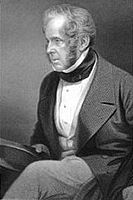Liberal government, 1859–1866 facts for kids
The Liberal government in the United Kingdom between 1859 and 1866 was made up of two main groups of leaders. These groups were known as the second Palmerston ministry and the second Russell ministry. A "ministry" is like a team of top government officials led by the Prime Minister. This government was formed by the Liberal Party.
Contents
A Look Back: How the Government Changed
After a short period when the Conservative Party was in charge, Lord Palmerston became Prime Minister again in 1859. This time, he worked with his former rival, Earl Russell. Their government is seen as the first true Liberal government.
Palmerston led the country as Prime Minister until he passed away in 1865. After his death, Earl Russell took over as the new Prime Minister. However, the Liberal Party members started to disagree among themselves. Because of this disunity, Russell's government fell apart the very next year, in 1866. Then, Lord Derby formed a new Conservative government.
Who Was in Charge? The Cabinets
A "cabinet" is a group of the most important ministers in the government. They help the Prime Minister make big decisions for the country.
Lord Palmerston's Cabinet (1859–1865)
Here are some of the key people in Lord Palmerston's government:
- Lord Palmerston – He was the First Lord of the Treasury (which is like the Prime Minister today) and the leader in the House of Commons.
- Lord Campbell – He was the Lord Chancellor, the most senior judge and a key legal advisor.
- Lord Granville – He was the Lord President of the Council, helping to manage government business. He also led the House of Lords.
- The Duke of Argyll – He held the role of Lord Privy Seal, another important government position.
- Sir George Cornewall Lewis – He was the Home Secretary, in charge of law and order within the country.
- Lord John Russell – He was the Foreign Secretary, dealing with other countries.
- The Duke of Newcastle – He was the Colonial Secretary, looking after the British Empire's colonies.
- Sidney Herbert – He was the Secretary for War, responsible for the army.
- Sir Charles Wood – He was the Secretary for India, managing affairs in British India.
- The Duke of Somerset – He was the First Lord of the Admiralty, in charge of the navy.
- William Ewart Gladstone – He was the Chancellor of the Exchequer, responsible for the country's money.
- Edward Cardwell – He was the Chief Secretary for Ireland, overseeing Ireland.
- Thomas Milner Gibson – He was the President of the Board of Trade, dealing with business and trade. He also looked after the Poor Law Board.
- Sir George Grey – He was the Chancellor of the Duchy of Lancaster, another government role.
- Lord Elgin – He was the Postmaster-General, in charge of mail services.
Changes in Palmerston's Cabinet
Over time, some people in Palmerston's cabinet changed roles or left:
- In 1861, Sir George Cornewall Lewis became Secretary for War, and Sir George Grey became Home Secretary.
- In 1863, Lord de Grey became Secretary for War.
- In 1864, Edward Cardwell became Colonial Secretary.
Earl Russell's Cabinet (1865–1866)
After Palmerston's death, Earl Russell formed his own cabinet. Here are some of the key members:
| Office | Name |
|---|---|
| First Lord of the Treasury Leader of the House of Lords |
The Earl Russell |
| Lord Chancellor | The Lord Cranworth |
| Lord President of the Council | The Earl Granville |
| Lord Privy Seal | The Duke of Argyll |
| Chancellor of the Exchequer Leader of the House of Commons |
William Ewart Gladstone |
| Home Secretary | Sir George Grey, Bt |
| Foreign Secretary | The Earl of Clarendon |
| Secretary of State for the Colonies | Edward Cardwell |
| Secretary of State for War | The Earl de Grey (until Feb 1866), then Marquess of Hartington |
| Secretary of State for India | Sir Charles Wood, Bt (until Feb 1866), then The Earl de Grey |
| First Lord of the Admiralty | The Duke of Somerset |
| President of the Board of Trade | Thomas Milner Gibson |
| Chancellor of the Duchy of Lancaster | George Goschen |
| President of the Poor Law Board | Charles Pelham Villiers |
| Postmaster General | The Lord Stanley of Alderley |
Changes in Russell's Cabinet
- In February 1866, Lord de Grey became Secretary for India. Lord Hartington then took over as Secretary for War.



